Total Quality Management: Kaizen, Six Sigma, and Event Agency
VerifiedAdded on 2020/04/15
|15
|3451
|40
Report
AI Summary
This report delves into the principles of Total Quality Management (TQM), emphasizing its role in organizational success through customer satisfaction, and explores the contributions of TQM gurus like Deming, Juran, Ishikawa, and Crosby. It examines the Kaizen and Six Sigma theories, highlighting their links to TQM and their importance in maintaining product and service quality. The report analyzes the application of these theories within the context of an event organization, Penguins event agency, illustrating how Kaizen (including the PDCA cycle and 5S technique) and Six Sigma can be implemented to improve event quality and customer satisfaction. It contrasts the approaches, noting Six Sigma's statistical complexity and the benefits of both theories in reducing errors and enhancing business processes. The report concludes by emphasizing the significance of continuous improvement and the strategic use of TQM methodologies to achieve competitive advantage in the events industry.
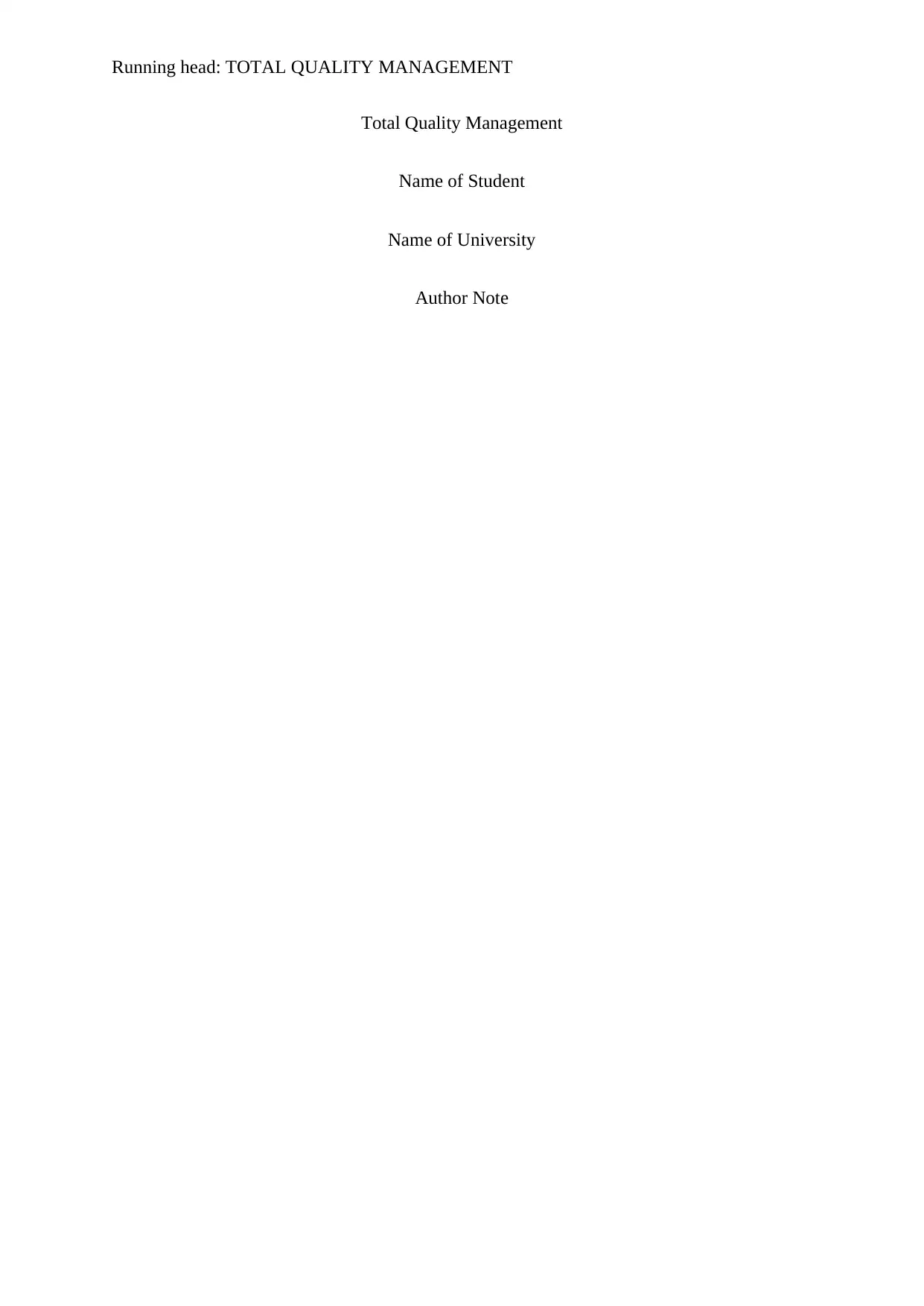
Running head: TOTAL QUALITY MANAGEMENT
Total Quality Management
Name of Student
Name of University
Author Note
Total Quality Management
Name of Student
Name of University
Author Note
Paraphrase This Document
Need a fresh take? Get an instant paraphrase of this document with our AI Paraphraser
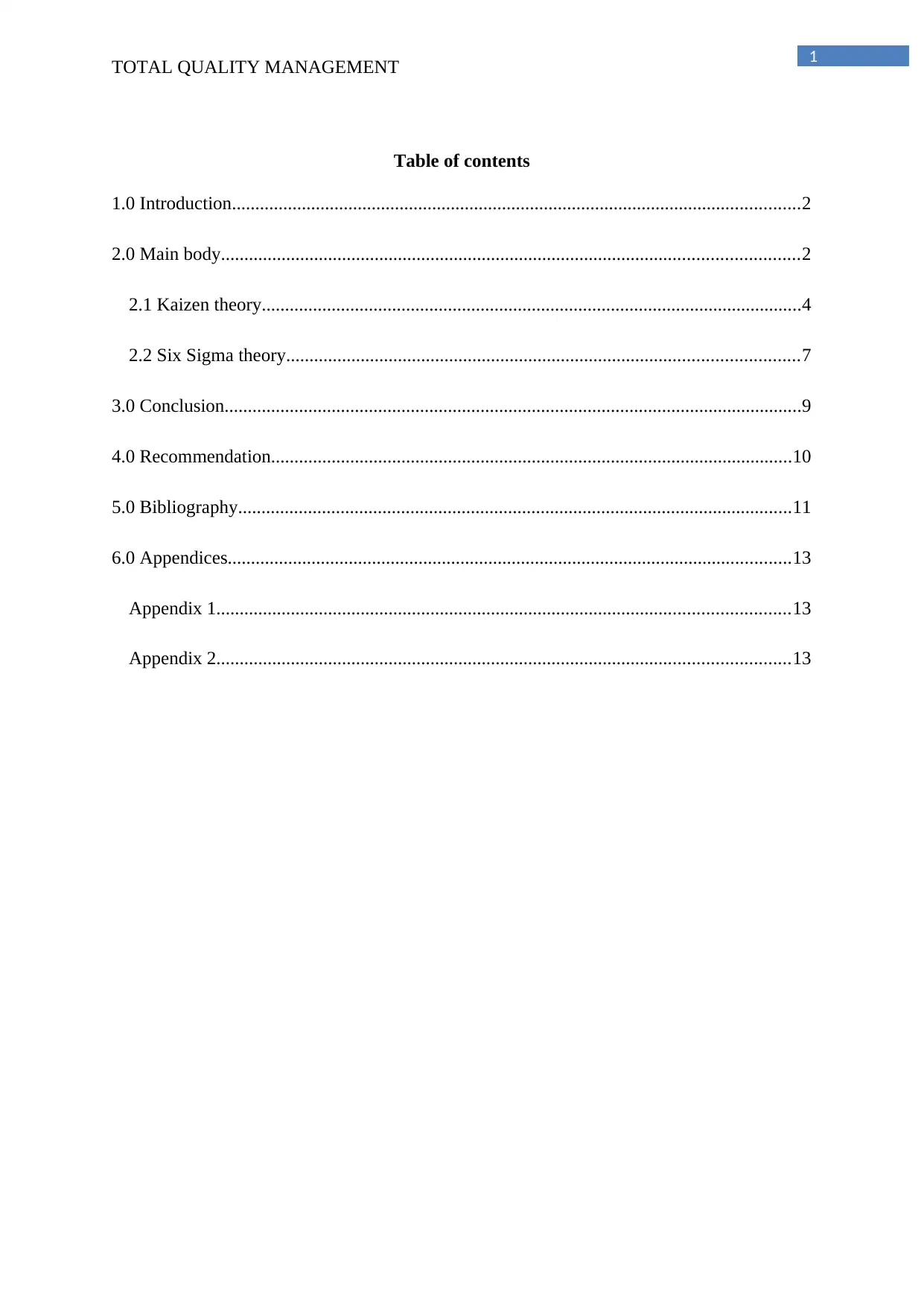
1
TOTAL QUALITY MANAGEMENT
Table of contents
1.0 Introduction..........................................................................................................................2
2.0 Main body............................................................................................................................2
2.1 Kaizen theory....................................................................................................................4
2.2 Six Sigma theory..............................................................................................................7
3.0 Conclusion............................................................................................................................9
4.0 Recommendation................................................................................................................10
5.0 Bibliography.......................................................................................................................11
6.0 Appendices.........................................................................................................................13
Appendix 1...........................................................................................................................13
Appendix 2...........................................................................................................................13
TOTAL QUALITY MANAGEMENT
Table of contents
1.0 Introduction..........................................................................................................................2
2.0 Main body............................................................................................................................2
2.1 Kaizen theory....................................................................................................................4
2.2 Six Sigma theory..............................................................................................................7
3.0 Conclusion............................................................................................................................9
4.0 Recommendation................................................................................................................10
5.0 Bibliography.......................................................................................................................11
6.0 Appendices.........................................................................................................................13
Appendix 1...........................................................................................................................13
Appendix 2...........................................................................................................................13
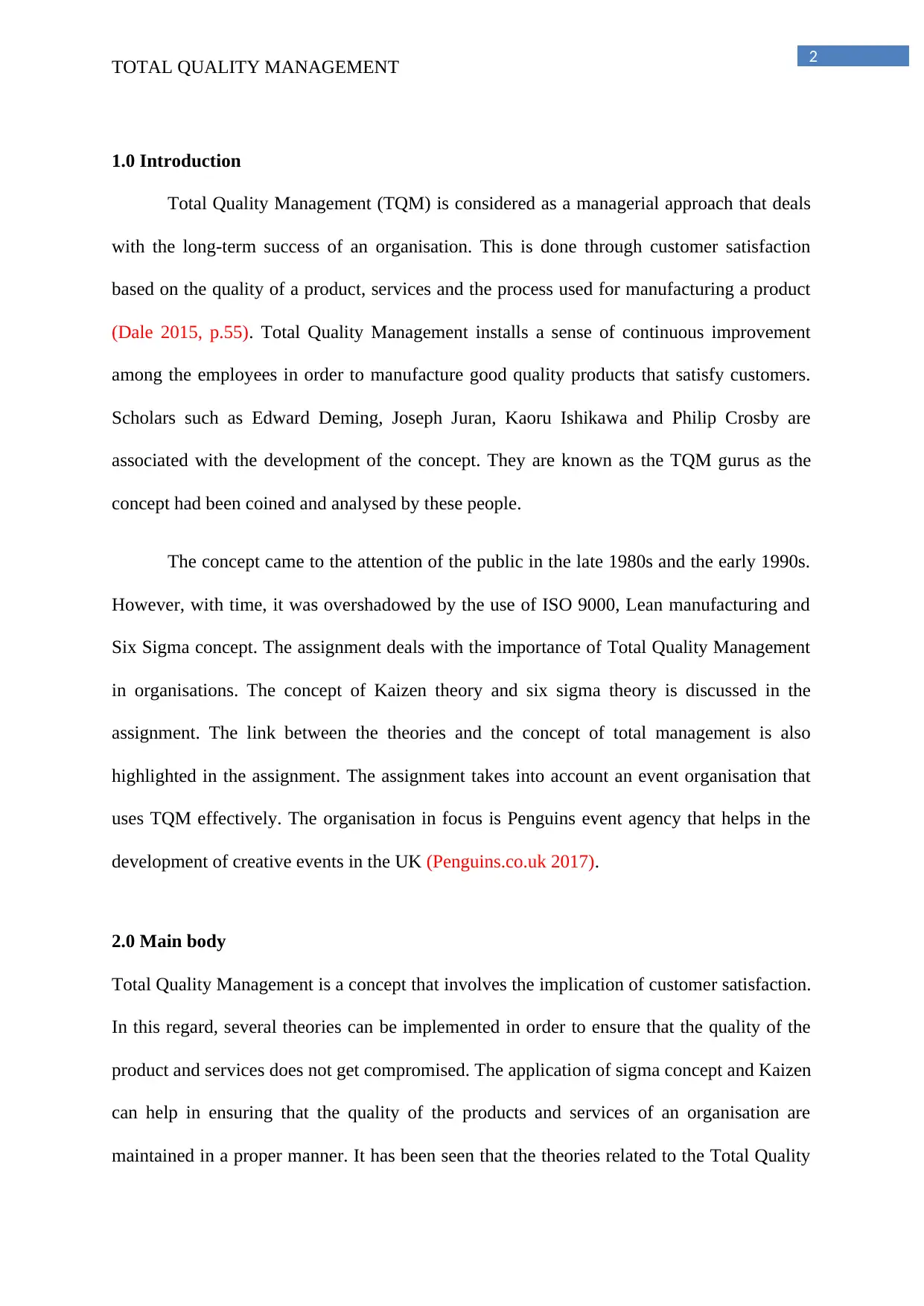
2
TOTAL QUALITY MANAGEMENT
1.0 Introduction
Total Quality Management (TQM) is considered as a managerial approach that deals
with the long-term success of an organisation. This is done through customer satisfaction
based on the quality of a product, services and the process used for manufacturing a product
(Dale 2015, p.55). Total Quality Management installs a sense of continuous improvement
among the employees in order to manufacture good quality products that satisfy customers.
Scholars such as Edward Deming, Joseph Juran, Kaoru Ishikawa and Philip Crosby are
associated with the development of the concept. They are known as the TQM gurus as the
concept had been coined and analysed by these people.
The concept came to the attention of the public in the late 1980s and the early 1990s.
However, with time, it was overshadowed by the use of ISO 9000, Lean manufacturing and
Six Sigma concept. The assignment deals with the importance of Total Quality Management
in organisations. The concept of Kaizen theory and six sigma theory is discussed in the
assignment. The link between the theories and the concept of total management is also
highlighted in the assignment. The assignment takes into account an event organisation that
uses TQM effectively. The organisation in focus is Penguins event agency that helps in the
development of creative events in the UK (Penguins.co.uk 2017).
2.0 Main body
Total Quality Management is a concept that involves the implication of customer satisfaction.
In this regard, several theories can be implemented in order to ensure that the quality of the
product and services does not get compromised. The application of sigma concept and Kaizen
can help in ensuring that the quality of the products and services of an organisation are
maintained in a proper manner. It has been seen that the theories related to the Total Quality
TOTAL QUALITY MANAGEMENT
1.0 Introduction
Total Quality Management (TQM) is considered as a managerial approach that deals
with the long-term success of an organisation. This is done through customer satisfaction
based on the quality of a product, services and the process used for manufacturing a product
(Dale 2015, p.55). Total Quality Management installs a sense of continuous improvement
among the employees in order to manufacture good quality products that satisfy customers.
Scholars such as Edward Deming, Joseph Juran, Kaoru Ishikawa and Philip Crosby are
associated with the development of the concept. They are known as the TQM gurus as the
concept had been coined and analysed by these people.
The concept came to the attention of the public in the late 1980s and the early 1990s.
However, with time, it was overshadowed by the use of ISO 9000, Lean manufacturing and
Six Sigma concept. The assignment deals with the importance of Total Quality Management
in organisations. The concept of Kaizen theory and six sigma theory is discussed in the
assignment. The link between the theories and the concept of total management is also
highlighted in the assignment. The assignment takes into account an event organisation that
uses TQM effectively. The organisation in focus is Penguins event agency that helps in the
development of creative events in the UK (Penguins.co.uk 2017).
2.0 Main body
Total Quality Management is a concept that involves the implication of customer satisfaction.
In this regard, several theories can be implemented in order to ensure that the quality of the
product and services does not get compromised. The application of sigma concept and Kaizen
can help in ensuring that the quality of the products and services of an organisation are
maintained in a proper manner. It has been seen that the theories related to the Total Quality
⊘ This is a preview!⊘
Do you want full access?
Subscribe today to unlock all pages.

Trusted by 1+ million students worldwide
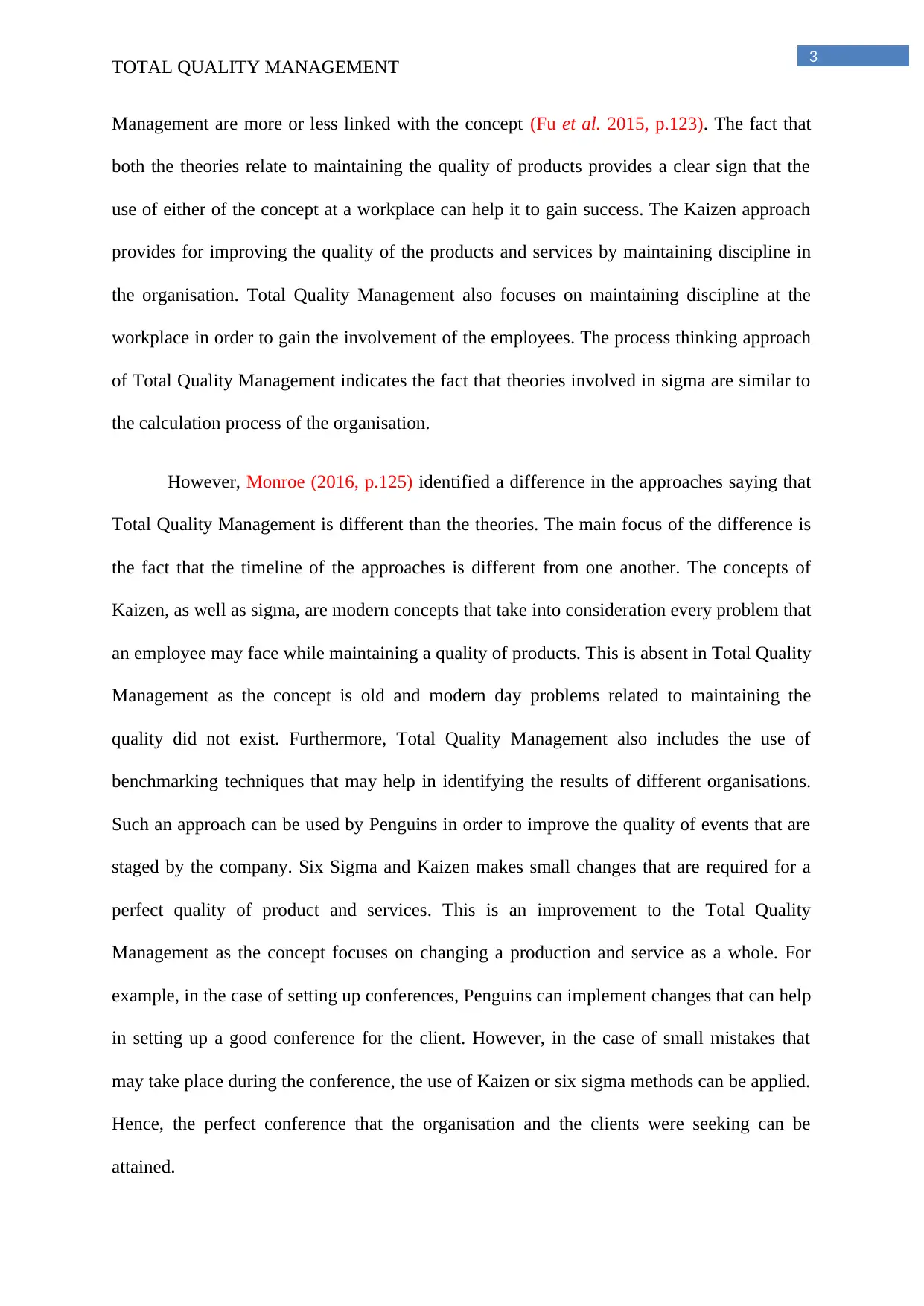
3
TOTAL QUALITY MANAGEMENT
Management are more or less linked with the concept (Fu et al. 2015, p.123). The fact that
both the theories relate to maintaining the quality of products provides a clear sign that the
use of either of the concept at a workplace can help it to gain success. The Kaizen approach
provides for improving the quality of the products and services by maintaining discipline in
the organisation. Total Quality Management also focuses on maintaining discipline at the
workplace in order to gain the involvement of the employees. The process thinking approach
of Total Quality Management indicates the fact that theories involved in sigma are similar to
the calculation process of the organisation.
However, Monroe (2016, p.125) identified a difference in the approaches saying that
Total Quality Management is different than the theories. The main focus of the difference is
the fact that the timeline of the approaches is different from one another. The concepts of
Kaizen, as well as sigma, are modern concepts that take into consideration every problem that
an employee may face while maintaining a quality of products. This is absent in Total Quality
Management as the concept is old and modern day problems related to maintaining the
quality did not exist. Furthermore, Total Quality Management also includes the use of
benchmarking techniques that may help in identifying the results of different organisations.
Such an approach can be used by Penguins in order to improve the quality of events that are
staged by the company. Six Sigma and Kaizen makes small changes that are required for a
perfect quality of product and services. This is an improvement to the Total Quality
Management as the concept focuses on changing a production and service as a whole. For
example, in the case of setting up conferences, Penguins can implement changes that can help
in setting up a good conference for the client. However, in the case of small mistakes that
may take place during the conference, the use of Kaizen or six sigma methods can be applied.
Hence, the perfect conference that the organisation and the clients were seeking can be
attained.
TOTAL QUALITY MANAGEMENT
Management are more or less linked with the concept (Fu et al. 2015, p.123). The fact that
both the theories relate to maintaining the quality of products provides a clear sign that the
use of either of the concept at a workplace can help it to gain success. The Kaizen approach
provides for improving the quality of the products and services by maintaining discipline in
the organisation. Total Quality Management also focuses on maintaining discipline at the
workplace in order to gain the involvement of the employees. The process thinking approach
of Total Quality Management indicates the fact that theories involved in sigma are similar to
the calculation process of the organisation.
However, Monroe (2016, p.125) identified a difference in the approaches saying that
Total Quality Management is different than the theories. The main focus of the difference is
the fact that the timeline of the approaches is different from one another. The concepts of
Kaizen, as well as sigma, are modern concepts that take into consideration every problem that
an employee may face while maintaining a quality of products. This is absent in Total Quality
Management as the concept is old and modern day problems related to maintaining the
quality did not exist. Furthermore, Total Quality Management also includes the use of
benchmarking techniques that may help in identifying the results of different organisations.
Such an approach can be used by Penguins in order to improve the quality of events that are
staged by the company. Six Sigma and Kaizen makes small changes that are required for a
perfect quality of product and services. This is an improvement to the Total Quality
Management as the concept focuses on changing a production and service as a whole. For
example, in the case of setting up conferences, Penguins can implement changes that can help
in setting up a good conference for the client. However, in the case of small mistakes that
may take place during the conference, the use of Kaizen or six sigma methods can be applied.
Hence, the perfect conference that the organisation and the clients were seeking can be
attained.
Paraphrase This Document
Need a fresh take? Get an instant paraphrase of this document with our AI Paraphraser
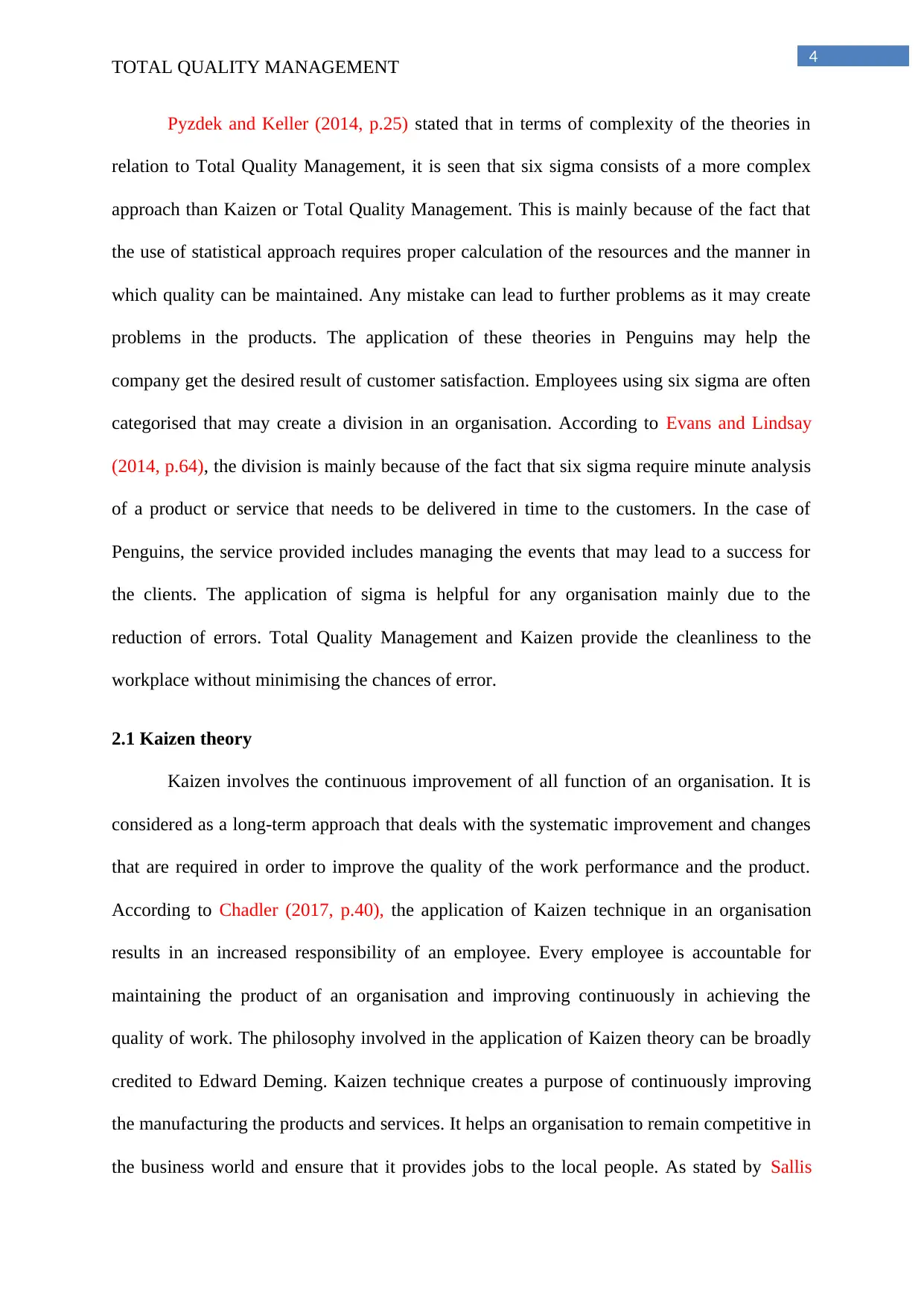
4
TOTAL QUALITY MANAGEMENT
Pyzdek and Keller (2014, p.25) stated that in terms of complexity of the theories in
relation to Total Quality Management, it is seen that six sigma consists of a more complex
approach than Kaizen or Total Quality Management. This is mainly because of the fact that
the use of statistical approach requires proper calculation of the resources and the manner in
which quality can be maintained. Any mistake can lead to further problems as it may create
problems in the products. The application of these theories in Penguins may help the
company get the desired result of customer satisfaction. Employees using six sigma are often
categorised that may create a division in an organisation. According to Evans and Lindsay
(2014, p.64), the division is mainly because of the fact that six sigma require minute analysis
of a product or service that needs to be delivered in time to the customers. In the case of
Penguins, the service provided includes managing the events that may lead to a success for
the clients. The application of sigma is helpful for any organisation mainly due to the
reduction of errors. Total Quality Management and Kaizen provide the cleanliness to the
workplace without minimising the chances of error.
2.1 Kaizen theory
Kaizen involves the continuous improvement of all function of an organisation. It is
considered as a long-term approach that deals with the systematic improvement and changes
that are required in order to improve the quality of the work performance and the product.
According to Chadler (2017, p.40), the application of Kaizen technique in an organisation
results in an increased responsibility of an employee. Every employee is accountable for
maintaining the product of an organisation and improving continuously in achieving the
quality of work. The philosophy involved in the application of Kaizen theory can be broadly
credited to Edward Deming. Kaizen technique creates a purpose of continuously improving
the manufacturing the products and services. It helps an organisation to remain competitive in
the business world and ensure that it provides jobs to the local people. As stated by Sallis
TOTAL QUALITY MANAGEMENT
Pyzdek and Keller (2014, p.25) stated that in terms of complexity of the theories in
relation to Total Quality Management, it is seen that six sigma consists of a more complex
approach than Kaizen or Total Quality Management. This is mainly because of the fact that
the use of statistical approach requires proper calculation of the resources and the manner in
which quality can be maintained. Any mistake can lead to further problems as it may create
problems in the products. The application of these theories in Penguins may help the
company get the desired result of customer satisfaction. Employees using six sigma are often
categorised that may create a division in an organisation. According to Evans and Lindsay
(2014, p.64), the division is mainly because of the fact that six sigma require minute analysis
of a product or service that needs to be delivered in time to the customers. In the case of
Penguins, the service provided includes managing the events that may lead to a success for
the clients. The application of sigma is helpful for any organisation mainly due to the
reduction of errors. Total Quality Management and Kaizen provide the cleanliness to the
workplace without minimising the chances of error.
2.1 Kaizen theory
Kaizen involves the continuous improvement of all function of an organisation. It is
considered as a long-term approach that deals with the systematic improvement and changes
that are required in order to improve the quality of the work performance and the product.
According to Chadler (2017, p.40), the application of Kaizen technique in an organisation
results in an increased responsibility of an employee. Every employee is accountable for
maintaining the product of an organisation and improving continuously in achieving the
quality of work. The philosophy involved in the application of Kaizen theory can be broadly
credited to Edward Deming. Kaizen technique creates a purpose of continuously improving
the manufacturing the products and services. It helps an organisation to remain competitive in
the business world and ensure that it provides jobs to the local people. As stated by Sallis
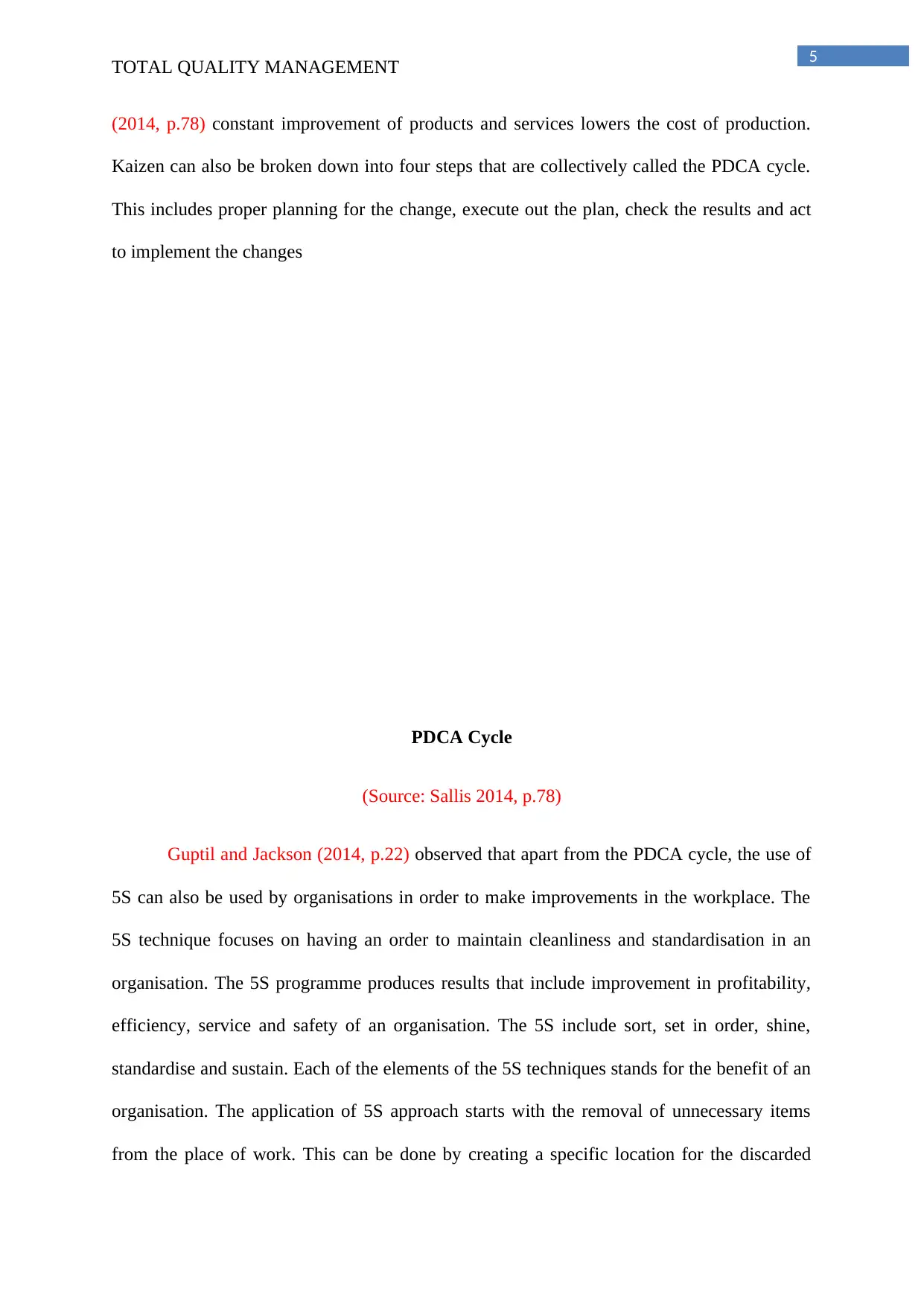
5
TOTAL QUALITY MANAGEMENT
(2014, p.78) constant improvement of products and services lowers the cost of production.
Kaizen can also be broken down into four steps that are collectively called the PDCA cycle.
This includes proper planning for the change, execute out the plan, check the results and act
to implement the changes
PDCA Cycle
(Source: Sallis 2014, p.78)
Guptil and Jackson (2014, p.22) observed that apart from the PDCA cycle, the use of
5S can also be used by organisations in order to make improvements in the workplace. The
5S technique focuses on having an order to maintain cleanliness and standardisation in an
organisation. The 5S programme produces results that include improvement in profitability,
efficiency, service and safety of an organisation. The 5S include sort, set in order, shine,
standardise and sustain. Each of the elements of the 5S techniques stands for the benefit of an
organisation. The application of 5S approach starts with the removal of unnecessary items
from the place of work. This can be done by creating a specific location for the discarded
PDCACycle
TOTAL QUALITY MANAGEMENT
(2014, p.78) constant improvement of products and services lowers the cost of production.
Kaizen can also be broken down into four steps that are collectively called the PDCA cycle.
This includes proper planning for the change, execute out the plan, check the results and act
to implement the changes
PDCA Cycle
(Source: Sallis 2014, p.78)
Guptil and Jackson (2014, p.22) observed that apart from the PDCA cycle, the use of
5S can also be used by organisations in order to make improvements in the workplace. The
5S technique focuses on having an order to maintain cleanliness and standardisation in an
organisation. The 5S programme produces results that include improvement in profitability,
efficiency, service and safety of an organisation. The 5S include sort, set in order, shine,
standardise and sustain. Each of the elements of the 5S techniques stands for the benefit of an
organisation. The application of 5S approach starts with the removal of unnecessary items
from the place of work. This can be done by creating a specific location for the discarded
PDCACycle
⊘ This is a preview!⊘
Do you want full access?
Subscribe today to unlock all pages.

Trusted by 1+ million students worldwide
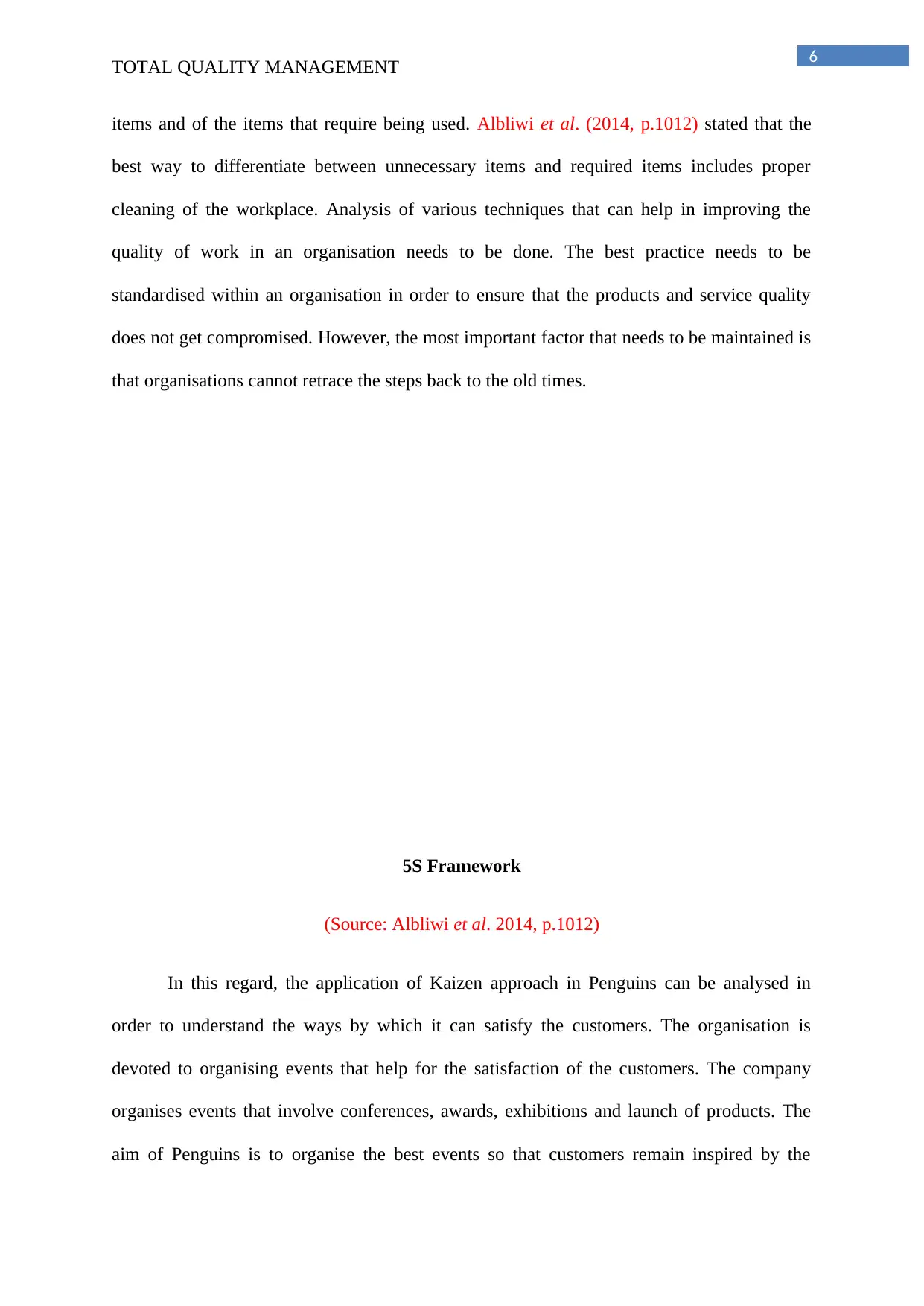
6
TOTAL QUALITY MANAGEMENT
items and of the items that require being used. Albliwi et al. (2014, p.1012) stated that the
best way to differentiate between unnecessary items and required items includes proper
cleaning of the workplace. Analysis of various techniques that can help in improving the
quality of work in an organisation needs to be done. The best practice needs to be
standardised within an organisation in order to ensure that the products and service quality
does not get compromised. However, the most important factor that needs to be maintained is
that organisations cannot retrace the steps back to the old times.
5S Framework
(Source: Albliwi et al. 2014, p.1012)
In this regard, the application of Kaizen approach in Penguins can be analysed in
order to understand the ways by which it can satisfy the customers. The organisation is
devoted to organising events that help for the satisfaction of the customers. The company
organises events that involve conferences, awards, exhibitions and launch of products. The
aim of Penguins is to organise the best events so that customers remain inspired by the
SortSetinorderShineStandardiseSustain
TOTAL QUALITY MANAGEMENT
items and of the items that require being used. Albliwi et al. (2014, p.1012) stated that the
best way to differentiate between unnecessary items and required items includes proper
cleaning of the workplace. Analysis of various techniques that can help in improving the
quality of work in an organisation needs to be done. The best practice needs to be
standardised within an organisation in order to ensure that the products and service quality
does not get compromised. However, the most important factor that needs to be maintained is
that organisations cannot retrace the steps back to the old times.
5S Framework
(Source: Albliwi et al. 2014, p.1012)
In this regard, the application of Kaizen approach in Penguins can be analysed in
order to understand the ways by which it can satisfy the customers. The organisation is
devoted to organising events that help for the satisfaction of the customers. The company
organises events that involve conferences, awards, exhibitions and launch of products. The
aim of Penguins is to organise the best events so that customers remain inspired by the
SortSetinorderShineStandardiseSustain
Paraphrase This Document
Need a fresh take? Get an instant paraphrase of this document with our AI Paraphraser
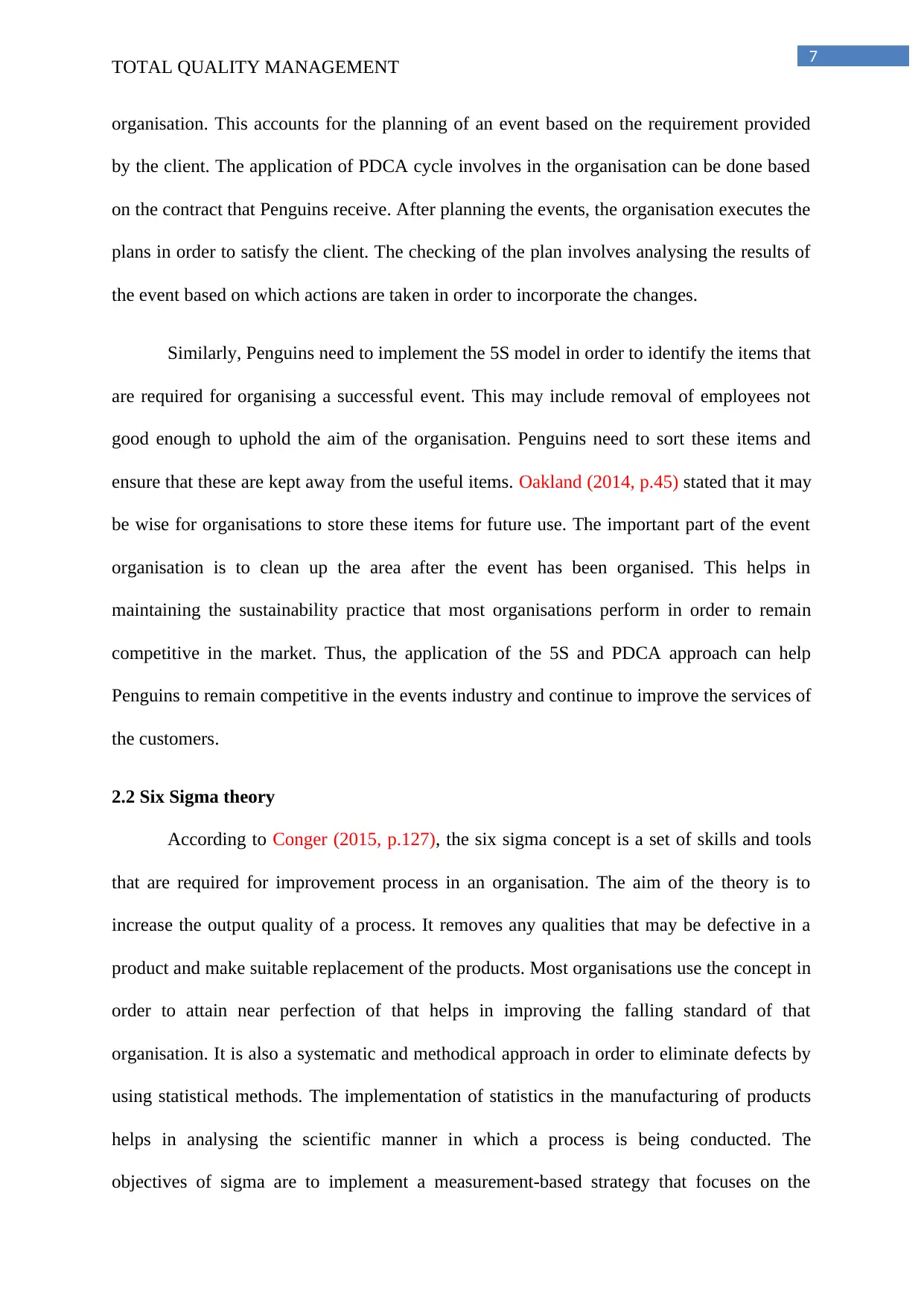
7
TOTAL QUALITY MANAGEMENT
organisation. This accounts for the planning of an event based on the requirement provided
by the client. The application of PDCA cycle involves in the organisation can be done based
on the contract that Penguins receive. After planning the events, the organisation executes the
plans in order to satisfy the client. The checking of the plan involves analysing the results of
the event based on which actions are taken in order to incorporate the changes.
Similarly, Penguins need to implement the 5S model in order to identify the items that
are required for organising a successful event. This may include removal of employees not
good enough to uphold the aim of the organisation. Penguins need to sort these items and
ensure that these are kept away from the useful items. Oakland (2014, p.45) stated that it may
be wise for organisations to store these items for future use. The important part of the event
organisation is to clean up the area after the event has been organised. This helps in
maintaining the sustainability practice that most organisations perform in order to remain
competitive in the market. Thus, the application of the 5S and PDCA approach can help
Penguins to remain competitive in the events industry and continue to improve the services of
the customers.
2.2 Six Sigma theory
According to Conger (2015, p.127), the six sigma concept is a set of skills and tools
that are required for improvement process in an organisation. The aim of the theory is to
increase the output quality of a process. It removes any qualities that may be defective in a
product and make suitable replacement of the products. Most organisations use the concept in
order to attain near perfection of that helps in improving the falling standard of that
organisation. It is also a systematic and methodical approach in order to eliminate defects by
using statistical methods. The implementation of statistics in the manufacturing of products
helps in analysing the scientific manner in which a process is being conducted. The
objectives of sigma are to implement a measurement-based strategy that focuses on the
TOTAL QUALITY MANAGEMENT
organisation. This accounts for the planning of an event based on the requirement provided
by the client. The application of PDCA cycle involves in the organisation can be done based
on the contract that Penguins receive. After planning the events, the organisation executes the
plans in order to satisfy the client. The checking of the plan involves analysing the results of
the event based on which actions are taken in order to incorporate the changes.
Similarly, Penguins need to implement the 5S model in order to identify the items that
are required for organising a successful event. This may include removal of employees not
good enough to uphold the aim of the organisation. Penguins need to sort these items and
ensure that these are kept away from the useful items. Oakland (2014, p.45) stated that it may
be wise for organisations to store these items for future use. The important part of the event
organisation is to clean up the area after the event has been organised. This helps in
maintaining the sustainability practice that most organisations perform in order to remain
competitive in the market. Thus, the application of the 5S and PDCA approach can help
Penguins to remain competitive in the events industry and continue to improve the services of
the customers.
2.2 Six Sigma theory
According to Conger (2015, p.127), the six sigma concept is a set of skills and tools
that are required for improvement process in an organisation. The aim of the theory is to
increase the output quality of a process. It removes any qualities that may be defective in a
product and make suitable replacement of the products. Most organisations use the concept in
order to attain near perfection of that helps in improving the falling standard of that
organisation. It is also a systematic and methodical approach in order to eliminate defects by
using statistical methods. The implementation of statistics in the manufacturing of products
helps in analysing the scientific manner in which a process is being conducted. The
objectives of sigma are to implement a measurement-based strategy that focuses on the
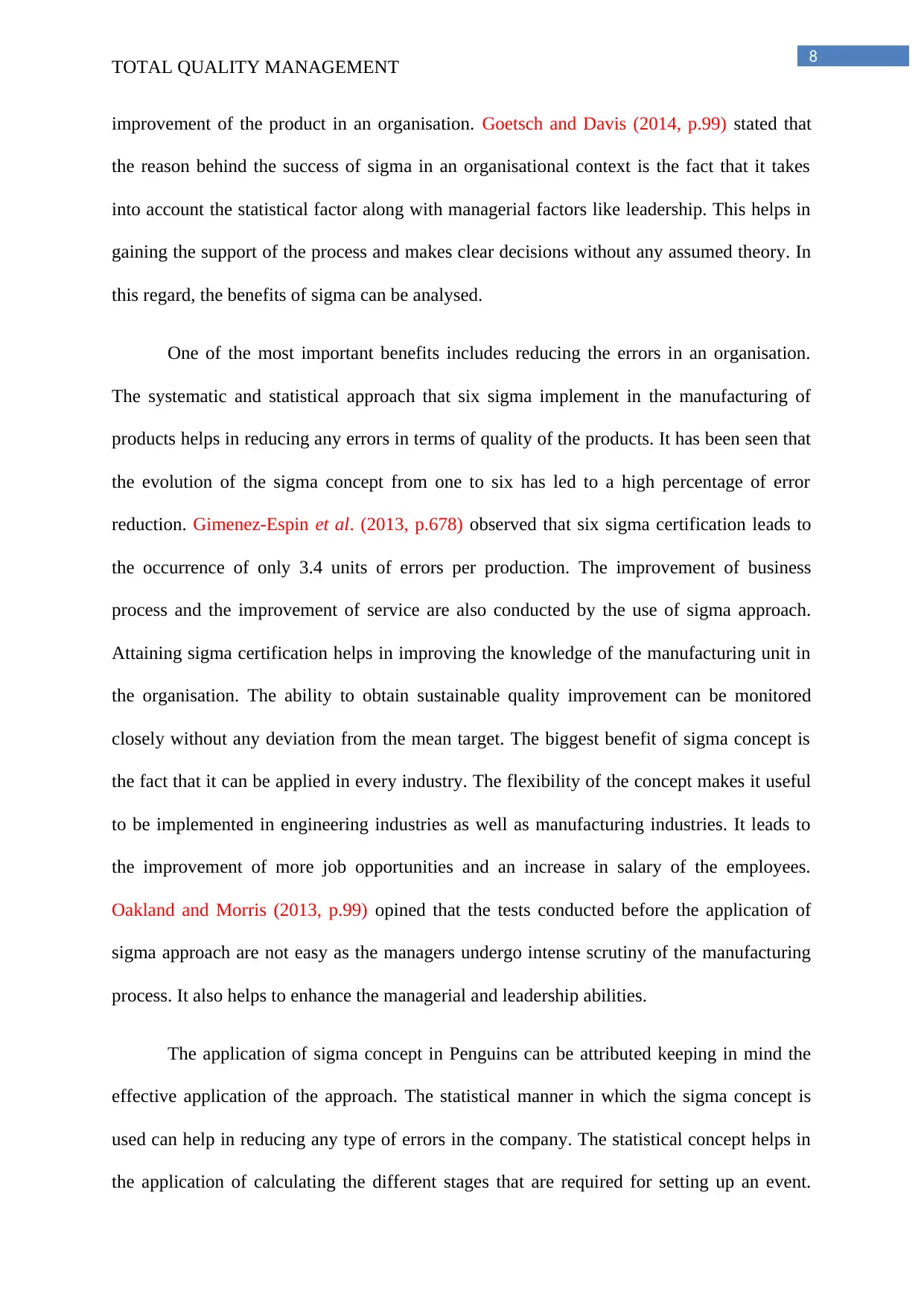
8
TOTAL QUALITY MANAGEMENT
improvement of the product in an organisation. Goetsch and Davis (2014, p.99) stated that
the reason behind the success of sigma in an organisational context is the fact that it takes
into account the statistical factor along with managerial factors like leadership. This helps in
gaining the support of the process and makes clear decisions without any assumed theory. In
this regard, the benefits of sigma can be analysed.
One of the most important benefits includes reducing the errors in an organisation.
The systematic and statistical approach that six sigma implement in the manufacturing of
products helps in reducing any errors in terms of quality of the products. It has been seen that
the evolution of the sigma concept from one to six has led to a high percentage of error
reduction. Gimenez-Espin et al. (2013, p.678) observed that six sigma certification leads to
the occurrence of only 3.4 units of errors per production. The improvement of business
process and the improvement of service are also conducted by the use of sigma approach.
Attaining sigma certification helps in improving the knowledge of the manufacturing unit in
the organisation. The ability to obtain sustainable quality improvement can be monitored
closely without any deviation from the mean target. The biggest benefit of sigma concept is
the fact that it can be applied in every industry. The flexibility of the concept makes it useful
to be implemented in engineering industries as well as manufacturing industries. It leads to
the improvement of more job opportunities and an increase in salary of the employees.
Oakland and Morris (2013, p.99) opined that the tests conducted before the application of
sigma approach are not easy as the managers undergo intense scrutiny of the manufacturing
process. It also helps to enhance the managerial and leadership abilities.
The application of sigma concept in Penguins can be attributed keeping in mind the
effective application of the approach. The statistical manner in which the sigma concept is
used can help in reducing any type of errors in the company. The statistical concept helps in
the application of calculating the different stages that are required for setting up an event.
TOTAL QUALITY MANAGEMENT
improvement of the product in an organisation. Goetsch and Davis (2014, p.99) stated that
the reason behind the success of sigma in an organisational context is the fact that it takes
into account the statistical factor along with managerial factors like leadership. This helps in
gaining the support of the process and makes clear decisions without any assumed theory. In
this regard, the benefits of sigma can be analysed.
One of the most important benefits includes reducing the errors in an organisation.
The systematic and statistical approach that six sigma implement in the manufacturing of
products helps in reducing any errors in terms of quality of the products. It has been seen that
the evolution of the sigma concept from one to six has led to a high percentage of error
reduction. Gimenez-Espin et al. (2013, p.678) observed that six sigma certification leads to
the occurrence of only 3.4 units of errors per production. The improvement of business
process and the improvement of service are also conducted by the use of sigma approach.
Attaining sigma certification helps in improving the knowledge of the manufacturing unit in
the organisation. The ability to obtain sustainable quality improvement can be monitored
closely without any deviation from the mean target. The biggest benefit of sigma concept is
the fact that it can be applied in every industry. The flexibility of the concept makes it useful
to be implemented in engineering industries as well as manufacturing industries. It leads to
the improvement of more job opportunities and an increase in salary of the employees.
Oakland and Morris (2013, p.99) opined that the tests conducted before the application of
sigma approach are not easy as the managers undergo intense scrutiny of the manufacturing
process. It also helps to enhance the managerial and leadership abilities.
The application of sigma concept in Penguins can be attributed keeping in mind the
effective application of the approach. The statistical manner in which the sigma concept is
used can help in reducing any type of errors in the company. The statistical concept helps in
the application of calculating the different stages that are required for setting up an event.
⊘ This is a preview!⊘
Do you want full access?
Subscribe today to unlock all pages.

Trusted by 1+ million students worldwide
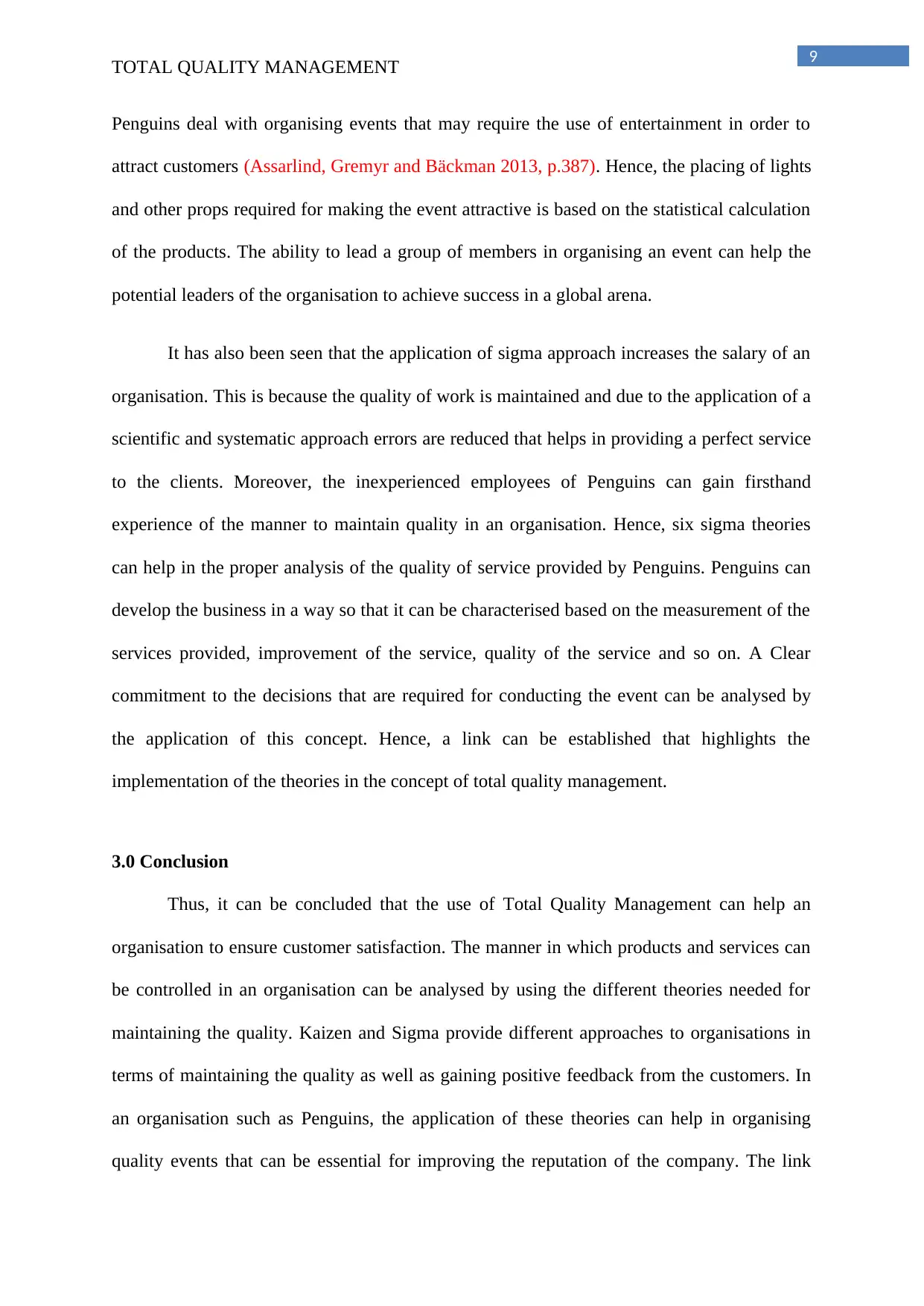
9
TOTAL QUALITY MANAGEMENT
Penguins deal with organising events that may require the use of entertainment in order to
attract customers (Assarlind, Gremyr and Bäckman 2013, p.387). Hence, the placing of lights
and other props required for making the event attractive is based on the statistical calculation
of the products. The ability to lead a group of members in organising an event can help the
potential leaders of the organisation to achieve success in a global arena.
It has also been seen that the application of sigma approach increases the salary of an
organisation. This is because the quality of work is maintained and due to the application of a
scientific and systematic approach errors are reduced that helps in providing a perfect service
to the clients. Moreover, the inexperienced employees of Penguins can gain firsthand
experience of the manner to maintain quality in an organisation. Hence, six sigma theories
can help in the proper analysis of the quality of service provided by Penguins. Penguins can
develop the business in a way so that it can be characterised based on the measurement of the
services provided, improvement of the service, quality of the service and so on. A Clear
commitment to the decisions that are required for conducting the event can be analysed by
the application of this concept. Hence, a link can be established that highlights the
implementation of the theories in the concept of total quality management.
3.0 Conclusion
Thus, it can be concluded that the use of Total Quality Management can help an
organisation to ensure customer satisfaction. The manner in which products and services can
be controlled in an organisation can be analysed by using the different theories needed for
maintaining the quality. Kaizen and Sigma provide different approaches to organisations in
terms of maintaining the quality as well as gaining positive feedback from the customers. In
an organisation such as Penguins, the application of these theories can help in organising
quality events that can be essential for improving the reputation of the company. The link
TOTAL QUALITY MANAGEMENT
Penguins deal with organising events that may require the use of entertainment in order to
attract customers (Assarlind, Gremyr and Bäckman 2013, p.387). Hence, the placing of lights
and other props required for making the event attractive is based on the statistical calculation
of the products. The ability to lead a group of members in organising an event can help the
potential leaders of the organisation to achieve success in a global arena.
It has also been seen that the application of sigma approach increases the salary of an
organisation. This is because the quality of work is maintained and due to the application of a
scientific and systematic approach errors are reduced that helps in providing a perfect service
to the clients. Moreover, the inexperienced employees of Penguins can gain firsthand
experience of the manner to maintain quality in an organisation. Hence, six sigma theories
can help in the proper analysis of the quality of service provided by Penguins. Penguins can
develop the business in a way so that it can be characterised based on the measurement of the
services provided, improvement of the service, quality of the service and so on. A Clear
commitment to the decisions that are required for conducting the event can be analysed by
the application of this concept. Hence, a link can be established that highlights the
implementation of the theories in the concept of total quality management.
3.0 Conclusion
Thus, it can be concluded that the use of Total Quality Management can help an
organisation to ensure customer satisfaction. The manner in which products and services can
be controlled in an organisation can be analysed by using the different theories needed for
maintaining the quality. Kaizen and Sigma provide different approaches to organisations in
terms of maintaining the quality as well as gaining positive feedback from the customers. In
an organisation such as Penguins, the application of these theories can help in organising
quality events that can be essential for improving the reputation of the company. The link
Paraphrase This Document
Need a fresh take? Get an instant paraphrase of this document with our AI Paraphraser
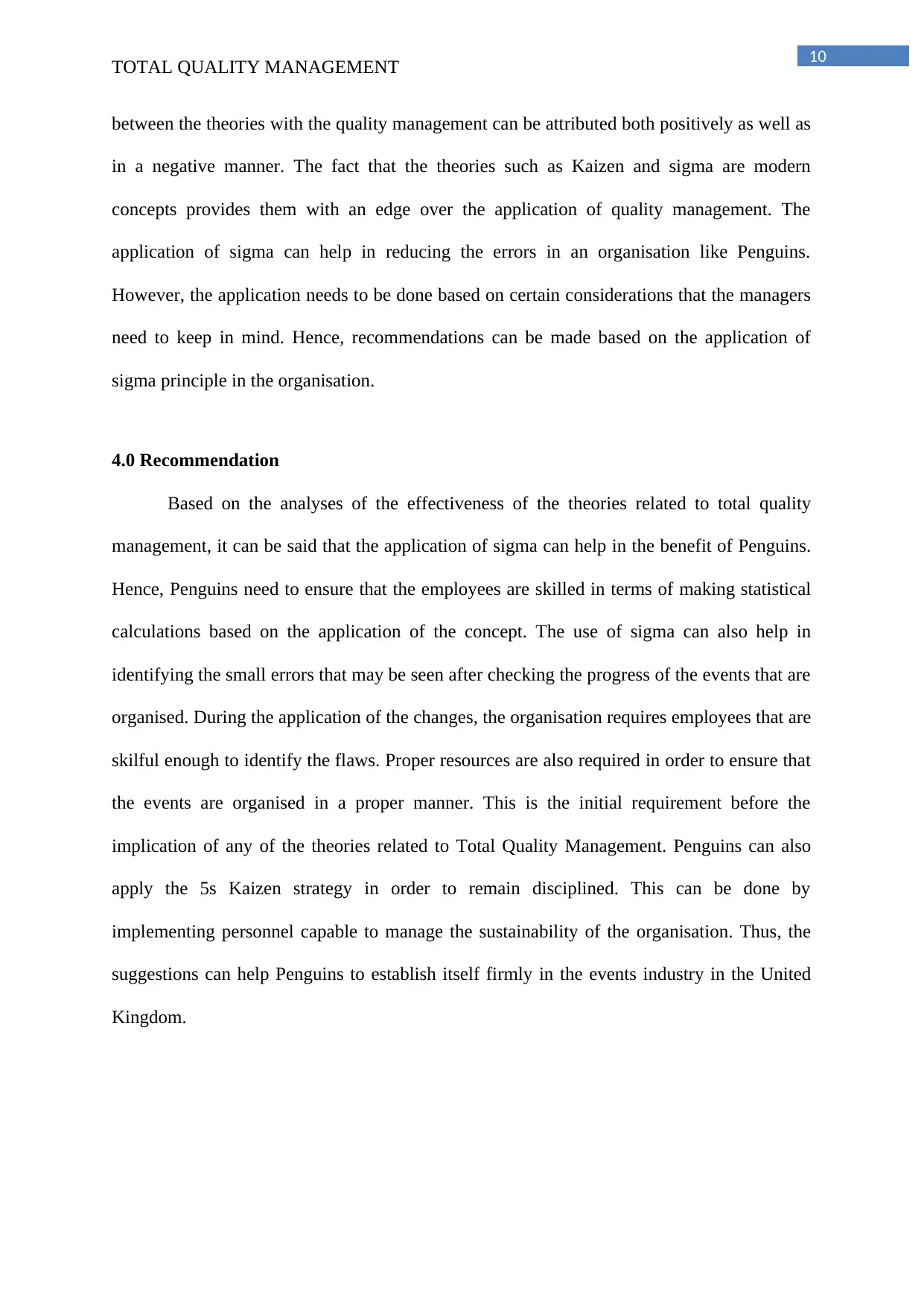
10
TOTAL QUALITY MANAGEMENT
between the theories with the quality management can be attributed both positively as well as
in a negative manner. The fact that the theories such as Kaizen and sigma are modern
concepts provides them with an edge over the application of quality management. The
application of sigma can help in reducing the errors in an organisation like Penguins.
However, the application needs to be done based on certain considerations that the managers
need to keep in mind. Hence, recommendations can be made based on the application of
sigma principle in the organisation.
4.0 Recommendation
Based on the analyses of the effectiveness of the theories related to total quality
management, it can be said that the application of sigma can help in the benefit of Penguins.
Hence, Penguins need to ensure that the employees are skilled in terms of making statistical
calculations based on the application of the concept. The use of sigma can also help in
identifying the small errors that may be seen after checking the progress of the events that are
organised. During the application of the changes, the organisation requires employees that are
skilful enough to identify the flaws. Proper resources are also required in order to ensure that
the events are organised in a proper manner. This is the initial requirement before the
implication of any of the theories related to Total Quality Management. Penguins can also
apply the 5s Kaizen strategy in order to remain disciplined. This can be done by
implementing personnel capable to manage the sustainability of the organisation. Thus, the
suggestions can help Penguins to establish itself firmly in the events industry in the United
Kingdom.
TOTAL QUALITY MANAGEMENT
between the theories with the quality management can be attributed both positively as well as
in a negative manner. The fact that the theories such as Kaizen and sigma are modern
concepts provides them with an edge over the application of quality management. The
application of sigma can help in reducing the errors in an organisation like Penguins.
However, the application needs to be done based on certain considerations that the managers
need to keep in mind. Hence, recommendations can be made based on the application of
sigma principle in the organisation.
4.0 Recommendation
Based on the analyses of the effectiveness of the theories related to total quality
management, it can be said that the application of sigma can help in the benefit of Penguins.
Hence, Penguins need to ensure that the employees are skilled in terms of making statistical
calculations based on the application of the concept. The use of sigma can also help in
identifying the small errors that may be seen after checking the progress of the events that are
organised. During the application of the changes, the organisation requires employees that are
skilful enough to identify the flaws. Proper resources are also required in order to ensure that
the events are organised in a proper manner. This is the initial requirement before the
implication of any of the theories related to Total Quality Management. Penguins can also
apply the 5s Kaizen strategy in order to remain disciplined. This can be done by
implementing personnel capable to manage the sustainability of the organisation. Thus, the
suggestions can help Penguins to establish itself firmly in the events industry in the United
Kingdom.
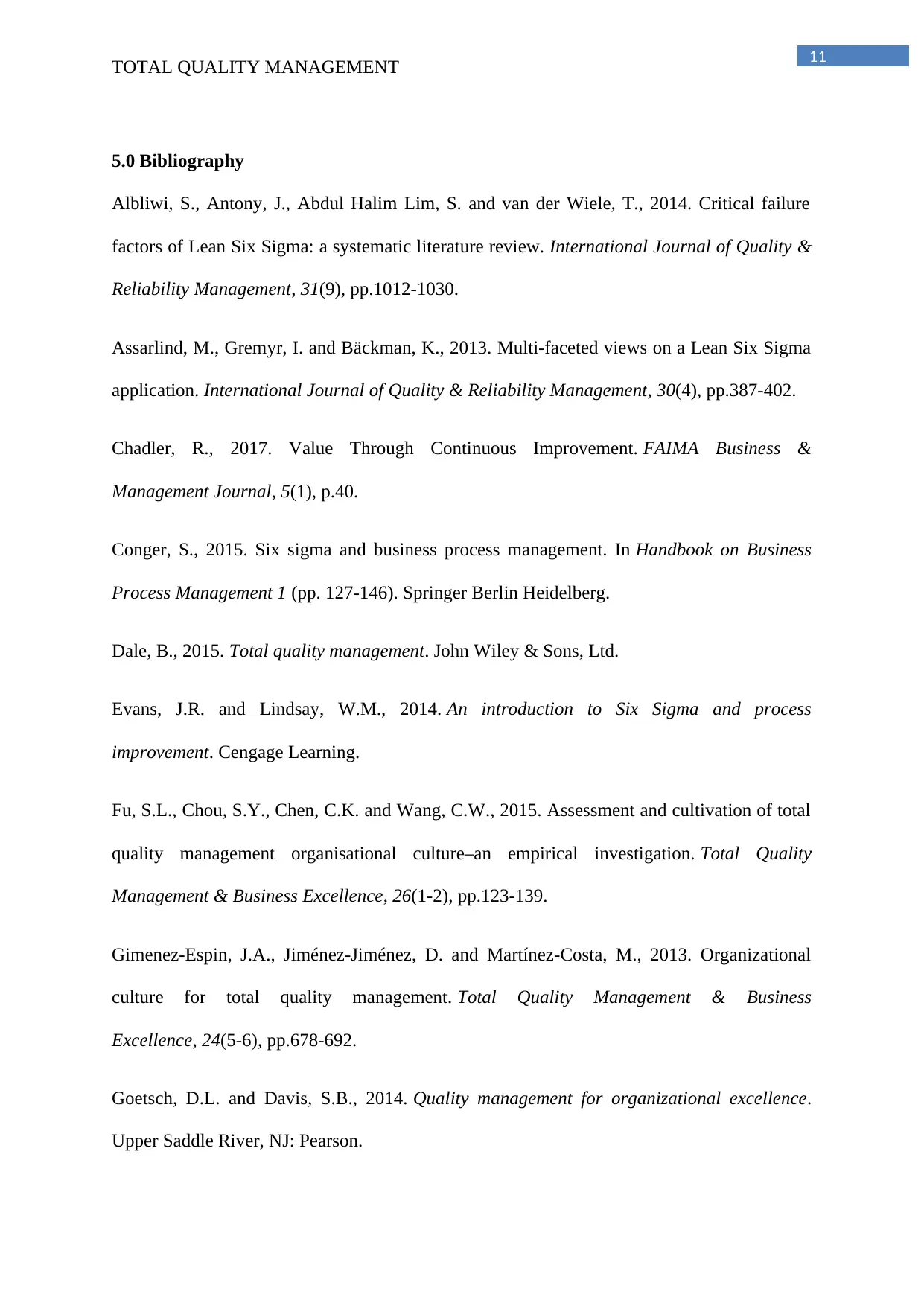
11
TOTAL QUALITY MANAGEMENT
5.0 Bibliography
Albliwi, S., Antony, J., Abdul Halim Lim, S. and van der Wiele, T., 2014. Critical failure
factors of Lean Six Sigma: a systematic literature review. International Journal of Quality &
Reliability Management, 31(9), pp.1012-1030.
Assarlind, M., Gremyr, I. and Bäckman, K., 2013. Multi-faceted views on a Lean Six Sigma
application. International Journal of Quality & Reliability Management, 30(4), pp.387-402.
Chadler, R., 2017. Value Through Continuous Improvement. FAIMA Business &
Management Journal, 5(1), p.40.
Conger, S., 2015. Six sigma and business process management. In Handbook on Business
Process Management 1 (pp. 127-146). Springer Berlin Heidelberg.
Dale, B., 2015. Total quality management. John Wiley & Sons, Ltd.
Evans, J.R. and Lindsay, W.M., 2014. An introduction to Six Sigma and process
improvement. Cengage Learning.
Fu, S.L., Chou, S.Y., Chen, C.K. and Wang, C.W., 2015. Assessment and cultivation of total
quality management organisational culture–an empirical investigation. Total Quality
Management & Business Excellence, 26(1-2), pp.123-139.
Gimenez-Espin, J.A., Jiménez-Jiménez, D. and Martínez-Costa, M., 2013. Organizational
culture for total quality management. Total Quality Management & Business
Excellence, 24(5-6), pp.678-692.
Goetsch, D.L. and Davis, S.B., 2014. Quality management for organizational excellence.
Upper Saddle River, NJ: Pearson.
TOTAL QUALITY MANAGEMENT
5.0 Bibliography
Albliwi, S., Antony, J., Abdul Halim Lim, S. and van der Wiele, T., 2014. Critical failure
factors of Lean Six Sigma: a systematic literature review. International Journal of Quality &
Reliability Management, 31(9), pp.1012-1030.
Assarlind, M., Gremyr, I. and Bäckman, K., 2013. Multi-faceted views on a Lean Six Sigma
application. International Journal of Quality & Reliability Management, 30(4), pp.387-402.
Chadler, R., 2017. Value Through Continuous Improvement. FAIMA Business &
Management Journal, 5(1), p.40.
Conger, S., 2015. Six sigma and business process management. In Handbook on Business
Process Management 1 (pp. 127-146). Springer Berlin Heidelberg.
Dale, B., 2015. Total quality management. John Wiley & Sons, Ltd.
Evans, J.R. and Lindsay, W.M., 2014. An introduction to Six Sigma and process
improvement. Cengage Learning.
Fu, S.L., Chou, S.Y., Chen, C.K. and Wang, C.W., 2015. Assessment and cultivation of total
quality management organisational culture–an empirical investigation. Total Quality
Management & Business Excellence, 26(1-2), pp.123-139.
Gimenez-Espin, J.A., Jiménez-Jiménez, D. and Martínez-Costa, M., 2013. Organizational
culture for total quality management. Total Quality Management & Business
Excellence, 24(5-6), pp.678-692.
Goetsch, D.L. and Davis, S.B., 2014. Quality management for organizational excellence.
Upper Saddle River, NJ: Pearson.
⊘ This is a preview!⊘
Do you want full access?
Subscribe today to unlock all pages.

Trusted by 1+ million students worldwide
1 out of 15
Related Documents
Your All-in-One AI-Powered Toolkit for Academic Success.
+13062052269
info@desklib.com
Available 24*7 on WhatsApp / Email
![[object Object]](/_next/static/media/star-bottom.7253800d.svg)
Unlock your academic potential
Copyright © 2020–2025 A2Z Services. All Rights Reserved. Developed and managed by ZUCOL.





